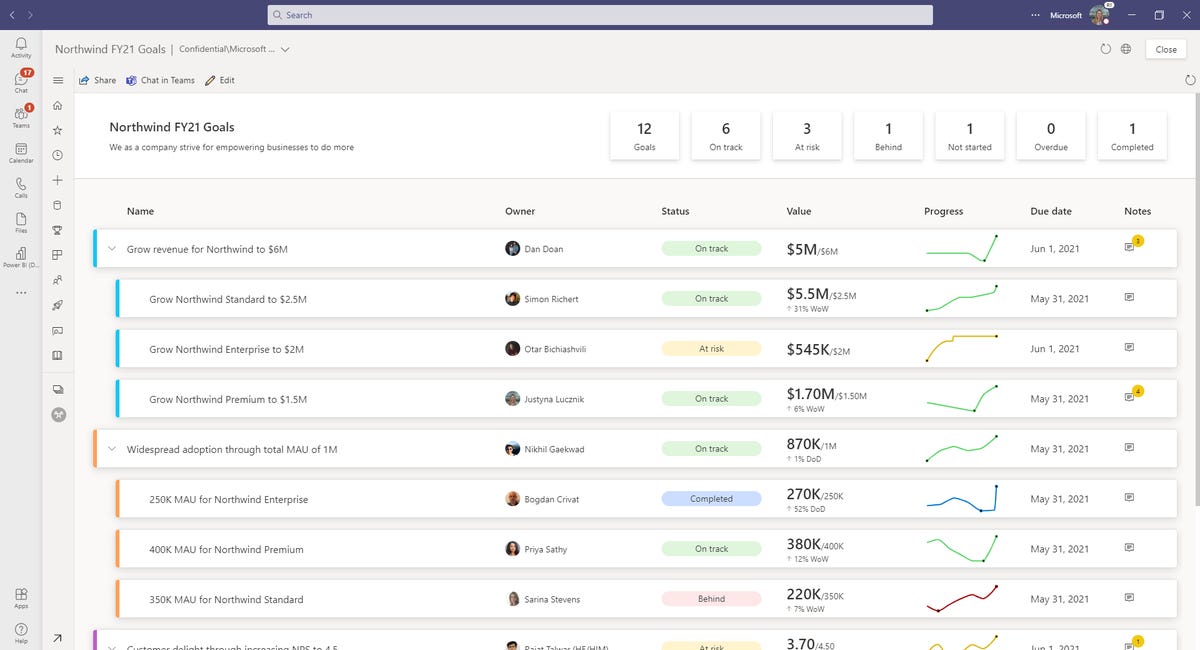
The Power BI Goals Hub
Credit: MicrosoftMicrosoft has done a lot with Power BI, but there are still some areas of enterprise business intelligence where it hasn’t yet wandered. One of those has been performance management, a high-end niche software category from the 2000s, dedicated to helping organizations track important metrics, set targets and manage progress toward them. But today, at its Microsoft Business Applications Summit (MBAS) virtual event, Microsoft is announcing the new Power BI Goals facility, a Power BI Premium feature that takes on performance management, cutting through the formality and rigidity that has been typical of products in the category.
Also read: As Power BI aces Gartner’s new Magic Quadrant, what’s the story behind Microsoft’s success?
Back on the horse
Performance management software, across the board, has historically been expensive and not exactly user-friendly, which has limited adoption. Microsoft itself had products in the space, starting with something called Business Scorecard Manager (BSM) in 2005, and followed by and the Monitoring component of product PerformancePoint Server (PPS) in 2007. Neither product was very good, and neither one succeeded: PPS replaced BSM and then was effectively discontinued in 2009. It’s not surprising that it took Microsoft more than ten years to build a performance management solution again. The good news, from what I’ve seen of Goals so far, is that Microsoft has learned from its past mistakes and built a streamlined, accessible solution, consistent with Power BI’s self-service credo and paradigm.
Power BI Goals leverages everything in Power BI, including its huge array of data connectors, which allows it to be connected to important business systems, including CRM, ERP, and sales quota tracking platforms, to keep the goals relevant and to minimize manual entry of data in a disconnected system. For now, Goals works in the browser only, requiring a desktop, laptop or tablet. But a mobile experience, optimized for phone screens, is coming soon.
Flexibility
One very cool thing about Goals is its methodology agnosticism. Individual goals in Power BI can function as key performance indicators (KPIs) or as key results from OKRs. The basic metadata of a goal includes its value, target, status, progress, an owner, and a due date as well as notes, which allow for comments/annotations. Targets and values can be entered manually, or data-driven. Right now, status must be manually set, but in the future Microsoft plans to make that data-driven as well.
Scorecards, a new Power BI asset, can present a collection of goals, either as a flat or hierarchical list. In the flat list configuration, a Power BI scorecard looks a bit like a screen in AirTable. In the hierarchical case, goals have sub goals which can, in turn have sub goals of their own. This makes it possible to use Power BI Goals to be largely compatible with the balanced scorecard methodology (although strategy maps are not available), but in no way requires customers to use that very doctrinaire approach of perspectives, objectives, parent KPIs and child KPIs.

A Power BI scorecard, with goals and sub goals.
Credit: MicrosoftDemocratized
Microsoft’s…uh…goal with this new facility was to democratize performance management (though it doesn’t use that term) and transform it into a self-service category. This is important, as it enables a bottom-up scenario for performance management, which has historically been almost exclusively top-down. Even data-driven goal parameters can be defined in a self-service fashion, wherein users open reports and click particular data points in visualizations (including even a slice in a pie/donut chart or a node in a decomposition tree), with Power BI taking care of determining and tracking historical values for these metrics.
The price is democratized too. Although Goals requires Power BI Premium, the Premium Per User (PPU) option that Microsoft brought to general availability just over a month ago, includes the feature as well. PPU is available for $20/month (or a $10/month add-on to Power BI Pro). That would be a low price point for even a standalone performance management solution; in the case of Goals you get it as a feature within a full BI platform instead.
Must read:
Integrations
As with the rest of Power BI, Goals integrates with Microsoft Teams, allowing performance management and workplace collaboration to come together. Scorecard creation generates a standard Power BI dataset, with a pre-designed model featuring tables for Goals, Scorecards and Values. This makes other integrations possible too, including with other Power Platform products like Power Apps and Power Automate, as well as Excel, which ostensibly could visualize goals using its conditional formatting and icon set features.
Dataset availability should also, of course, allow users to build their own standard Power BI reports on the goal/scorecard data. While that’s a bit “meta” and could be hard to grasp at first, it makes for some potentially powerful use cases. And scorecards are accessible from Power BI Embedded, which makes all of these performance management capabilities available to developers in their own applications, too.
Next up?
Other integrations would be useful, including with Microsoft Planner (also available as the Tasks app in Teams), Microsoft To-Do, Outlook tasks, Microsoft Lists, Dynamics 365 and the KPI feature in SQL Server Analysis Services and Azure Analysis Services. Analysis Services’ KPI feature also extends to Power BI datasets, and Power BI already has its own KPI visualization, both of which Goals works independently of. There’s also the question of whether and how Power BI’s natural language query feature, Q&A, can be used with Goals.
Microsoft does have plans to enhance Goals on a steady, iterative basis, as it has done with the Power BI product overall. Unlike with the legacy Business Scorecard Manager and PerformancePoint products, Microsoft isn’t trying to build out every feature in advance, isolated from user feedback. The iterative approach is a good omen for Goals, a feature that could genuinely help organizations along in their digital transformation initiatives.
Microsoft is a customer of Brust’s advisory firm, Blue Badge Insights. He is also a Microsoft Data Platform MVP.






















